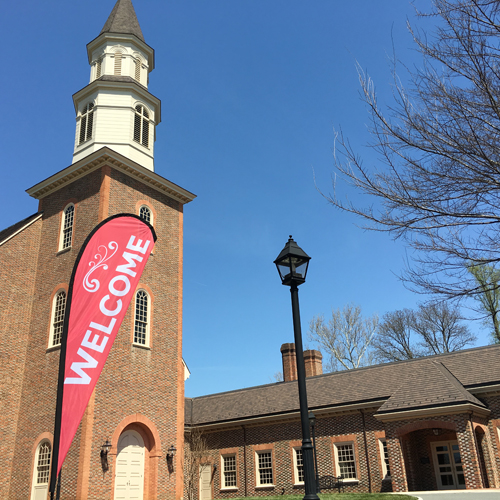
REVEILLE’S HISTORY
THE CHURCH
Reveille Church was formed in 1951 from a merger between Union Station Methodist Church and Monument Methodist Church. Union Station Church was relocating to the West End due to the changing demographics of its neighborhood on Church Hill. Union Station (named because it was a “station,” or single-church, appointment instead of a circuit) traced its origins back to a Methodist class founded in 1835 by members of Trinity Church and Centenary Church. Monument Church, also facing changing neighborhood demographics, had recently suffered a devastating fire at its location at Park and Allen Avenues. An 1888 class from Laurel Street Methodist Church gave rise to the membership that would become Monument Church.
The new, not-yet-named church met for its first worship service on June 24, 1951 at Thomas Jefferson High School, under the leadership of Rev. Dr. Joseph S. Johnston. Soon after the building committee secured nearby Reveille House and its grounds (the so-called “Seven Acres Set-Apart”). The name “Reveille” was adopted for the church and services were held in a new building at the present location on October 31, 1954.
Building continued in 1962 with the construction of a social hall and classrooms. In 1965, Reveille Weekday School opened. It has grown to be regarded as one of the city’s finest preschools.
The Garth at Reveille was part of the church’s 1951 master building plan, but was only completed and dedicated in 1994. This cloistered garden of tranquility and beauty includes a consecrated burial ground for members who select cremation. Learn more about The Garth.
On March 20, 2011, ground was broken for the youth center, choir room, welcome center, and chapel. The new facilities opened in May 2012.
Since its establishment, Reveille has been known in Richmond and in the Virginia Conference for its ministries. Strong preaching and stirring music have been central parts of faithful Wesleyan worship at Reveille. Throughout its history, the congregation at Reveille has engaged in missions at home and abroad. Education has always been a hallmark of life at Reveille. Active adult classes and Bible study, on Sunday morning and during the week, and vibrant children’s programs continue to be central parts of discipleship. This tradition of ministry continues today—come join us and see how we can grow in Christ together!


REVEILLE HOUSE
Reveille House, once part of a large plantation facing the James River, is the second-oldest house in Richmond. The land surrounding it was part of a grant by the King of England to the Kennon family, whose Virginia holdings amounted to 50,000 acres. They built the house here as early as 1720. By 1800, “The Brick House Tract” was a landmark along the Westham Plank Road (now Cary Street). In 1842, the house was acquired by Phillip Mayo Tabb and his wife Martha. Family legend tells that Martha insisted everyone in the household awake before sunrise and the term “reveille call” was well-known by the children. It later came to be applied to the estate, as Henrico County records from 1852 indicate the purchase of “…the Brick House Tract, now called Reveille.”
After the Civil War, the house was owned by Confederate veteran and tobacco magnate Dr. R. A. Patterson. Click here to watch a biography of Dr. Patterson, produced by Henrico County Public Relations and Media Services.
Patterson’s daughter, Mrs. E. M. Crutchfield, died without children in 1949. Her will instructed the house be turned over to the Association for the Preservation of Virginia Antiquities (APVA) as a museum. The APVA was unable to accept the property with the stipulations and so it was available to be sold. The new church formed by the merger of Union Station and Monument Methodist Churches purchased the house and grounds in 1951.
The house is listed on the National Register of Historic Places. The architecture of the house is a mix of Federal and Greek Revival styles. The West Wing, which is the dining room, was added to the original house in 1839. The kitchen wing was added in 1920 by the last owner, Elizabeth Crutchfield. Today the house is cared for by the Reveille House Guild and the house serves as the administrative center of the church.
THE GARDEN
It is not known when the formal garden was first planted. Laid out in the manner of an eighteenth-century English garden, the beds were extensive, box wood-lined, and required talented gardeners to keep them in prime condition. When Reveille acquired the property in 1951, the garden was sadly overgrown, and the pattern was too complex for the role it now had to play.
The restoration of the garden to its present form began in 1962. Present-day borders follow the lines of the early plan with many of the original plants still thriving. The boxwood alleé or carriage row still marks the route the horses and carriages took from the stables to the front door of Reveille House.
The church has felt an obligation to save this unique part of its heritage as a place of retreat from the bustle of city life and so future generations would know and enjoy Reveille’s “lovely garden.” The gardens are maintained by the Garden Committee each week, spring to fall.

CANVASWORK COMMUNION KNEELERS
The original booklet, Canvaswork Kneelers of Reveille United Methodist Church, has been updated with color photos throughout. Printed copies of the booklet are available by emailing administration@reveilleumc.org or calling (804) 359-6041, ext. 125.
The kneelers were designed by Mary Margaret Eutsler Abramson, daughter of Dr. and Mrs. R. Kern Eutsler, the senior minister at the time the project was implemented. There are seventeen kneelers surrounded by grape leaves signifying the wine used at the service of Holy Communion.
